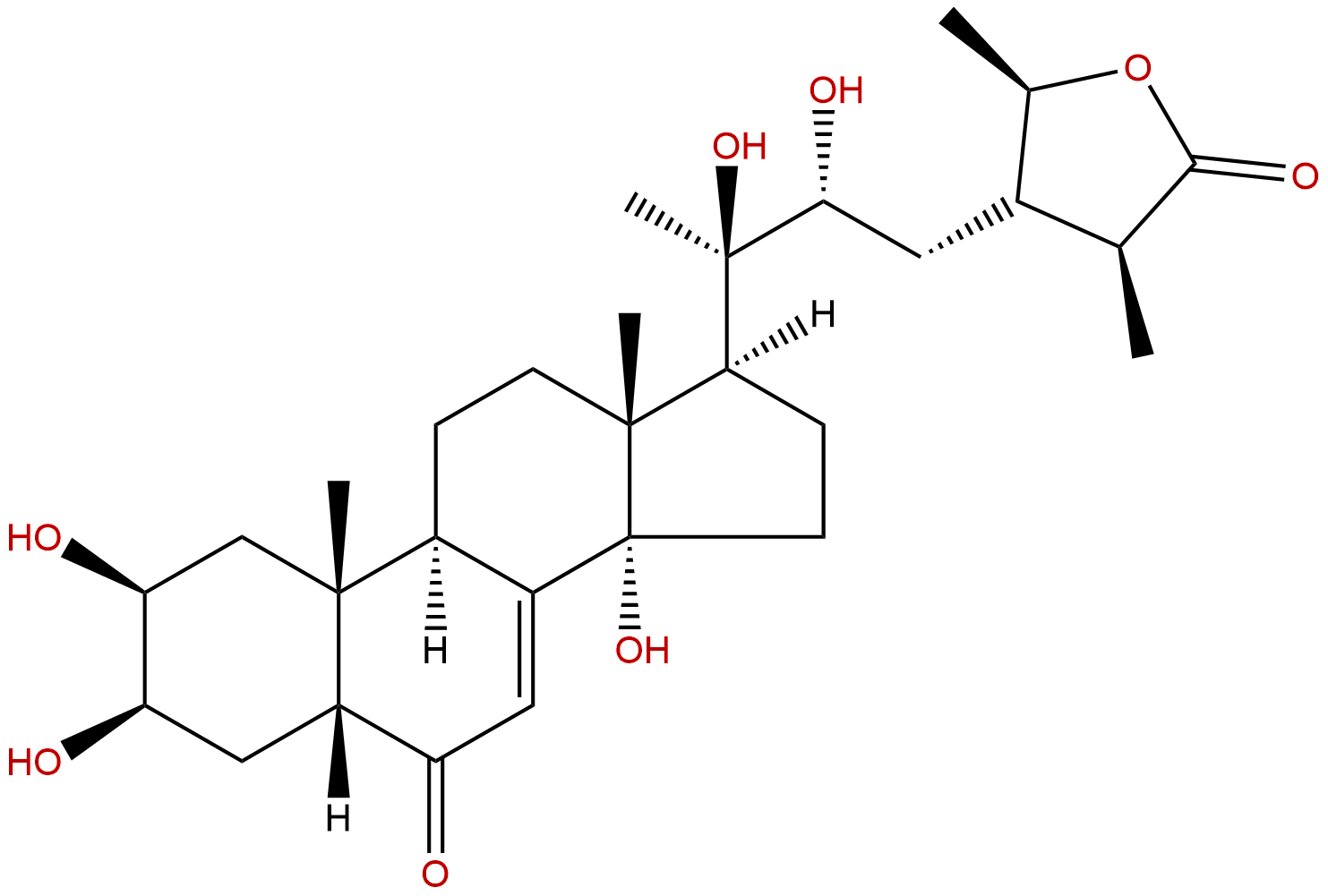
CyasteroneCAS No.:17086-76-9
|
||||||||||
 |
|
|
||||||||

| Catalogue No.: | BP0432 |
| Formula: | C29H44O8 |
| Mol Weight: | 520.663 |
Product name: Cyasterone
Synonym name:
Catalogue No.: BP0432
Cas No.: 17086-76-9
Formula: C29H44O8
Mol Weight: 520.663
Botanical Source: Achyranthes bidentata Bl.
Physical Description:
Type of Compound: Steroids
Purity: 95%~99%
Analysis Method: HPLC-DAD or/and HPLC-ELSD
Identification Method: Mass, NMR
Packing: Brown vial or HDPE plastic bottle
Storage: Store in a well closed container, protected from air and light. Put into refrigerate or freeze for long term storage.
Whenever possible, you should prepare and use solutions on the same day. However, if you need to make up stock solutions in advance, we recommend that you store the solution as aliquots in tightly sealed vials at -20℃. Generally, these will be useable for up to two weeks.
The product could be supplied from milligrams to grams
Inquire for bulk scale.
Description:
Cyasterone, a natural EGFR inhibitor, can inhibit growth of A549 and MGC823 cells, via regulating EGFR signaling pathway, it maybe a promising anti-cancer agent; it also has antifeeding activity.
References:
Insect Sci., 2001, 8(3):233-9.
Effects of cyasterone on growth and development of diamondback moth, Plutella xylostella (L.)
Cyasterone is the main phytoecdysteroid component from cultured plants of Ajuga nipponensis, and common in other Ajuga species.
METHODS AND RESULTS:
Results showed that when treated with 50 mg/L Cyasterone, the egg hatching of diamondback moth was retarded. The total percentage of eggs hatched in treatment was 94.7%, significantly less than that in control, which was 100%. Low toxicity and good antifeeding activity to the 3rd instar larvae were exhibited, which are dependent upon concentration. The growth and development of diamondback moth were affected by Cyasterone. It was found that, at concentrations higher than 50 mg/L Cyasterone, the larval growth and egg production were inhibited; while promoted at lower concentrations.
CONCLUSIONS:
This dual role of Cyasterone might be attributed to its hormonal activity and antifeeding activity, which resulted in poor nutrition. The pupation and eclosion were hindered by treatment of larvae. This insect species was more susceptible to Cyasterone than 20-hydroxyecdysone.
Biomed. Pharmacother., 2016, 84:330-9.
Anti-proliferation effects, efficacy of cyasterone in vitro and in vivo and its mechanism.
Cyasterone was demonstrated potential inhibition effect in mouse skin carcinoma cells in published report. However, the molecular mechanisms of the Cyasterone on cells remain unknown.
METHODS AND RESULTS:
Herein, we investigated the effects of Cyasterone-induced apoptosis in A549 and MGC823 cells in vitro. MTT assay showed that Cyasterone caused a significantly decreasing of the proliferation of A549 and MGC823 cells in a time-and dose-dependent manner with IC50 values of 38.50±3.73μg/mL on A549 cells and 32.96±1.24μg/mL on MGC823 cells at 48h, respectively. Hoechst staining and TUNEL staining results indicated the quintessential apoptosis features in immunofluorescence image. Apoptosis and cell cycle were determined by flow cytometry. Cyasterone treatment triggered inhibition of epidermal growth factor receptor- phosphatidylinositol 3 kinase/protein kinase B (EGFR-AKT) signaling pathways and activation of P38 pathways. Furthermore, Cyasteroneinhibited MGC823 cells xenografted tumor growth in vivo with few changes in body weights.
CONCLUSIONS:
In conclusion, our findings provide the evidence that Cyasterone inhibits growth of A549 and MGC823 cells, via regulating EGFR signaling pathway. Our results indicated that Cyasterone, a natural EGFR inhibitor, maybe a promising anti-cancer agent.